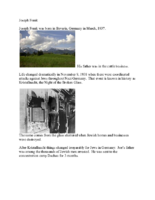Search the Special Collections and Archives Portal
Search Results

Film transparency of the face of Hoover (Boulder) Dam, taken from the downstream side of the dam on the Arizona side, May, 1947
Date
Archival Collection
Description
Image


Biographical essay about Henry Kronberg, 2014
Date
Archival Collection
Description
Henry Kronberg was nineteen when the Nazis invaded Poland. He was sent to several labor camps, and liberated in 1945.
Text

Biographical essay about Janos Strauss, 2014
Date
Archival Collection
Description
Janos Strauss was picked up by the Nazis at age 15, but lied and said he was 17, which saved his life. He was liberated during a transport in 1945.
Text

Biographical essay about Joseph Frank, 2014
Date
Archival Collection
Description
Joe Frank's family lived in Germany during Kristallnacht, and was able to escape to England in 1939. They came to the United States in 1940.
Text

Biographical essay about Stephen Nasser, 2014
Date
Archival Collection
Description
Stephen Nasser's family was forced into a ghetto in Hungary, and then sent to an internment camp in 1944. He was liberated from Muhldorf in 1945.
Text
Dick Hannah's records from Carl Byoir & Associates, 1946-1976
Level of Description
Scope and Contents
This series dates from 1946-1976 and contains correspondence, memos, newsletters, expenses, distribution lists, directories, and press releases generated by Dick Hannah and the staff of Carl Byoir & Associates, a public relations firm hired by Howard Hughes to oversee public relations for himself and his companies.
Archival Collection
Collection Name: Howard Hughes Public Relations Reference Files
Box/Folder: N/A
Archival Component
AIA 2015 Excellence In Design Awards, 2015
Level of Description
Scope and Contents
The AIA 2015 Excellence In Design Awards series contain digital files of award submittal forms, project presentation files, project photographs, and computer-generated images submitted to AIA Nevada for the AIA 2015 Excellence In Design Awards. These files are available as access copies generated from USB flash drives and optical discs donated by the AIA Las Vegas Chapter.
Project identification (ID) numbers refer to the original project identification numbers used by AIA Las Vegas Chapter for filing purposes. Of the project identification prefixes, "B" refers to the Built Category, or buildings that had been completed within the competition's year. "UB" refers to the Unbuilt Category, or projects designed as part of a competition, but either have not been built yet, or may never be built. "CA" refers to Collaborative Achievement, or projects designed and constructed by a collaborative team. "AP" refers to the Academic Projects, or projects created by students in a studio or class setting.
Creator refers to the individual, architectural firm, organization, or project team responsible for a project's design. Location refers to a project's proposed site, current site, or previously existing site of construction. Some variances in project titles and location names exist and are noted at the file level of this inventory.
Archival Collection
Collection Name: American Institute of Architects (AIA) Nevada Design & Service Awards Records
Box/Folder: N/A
Archival Component


